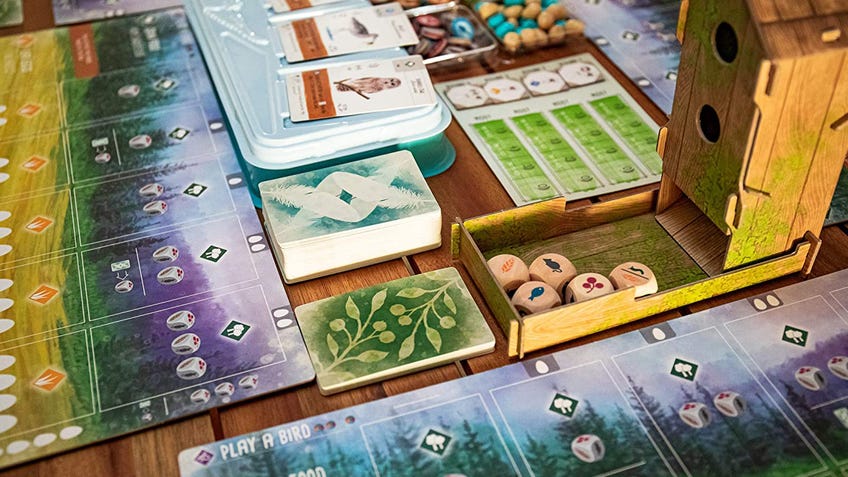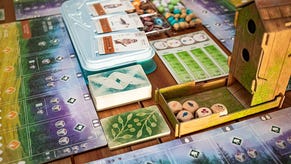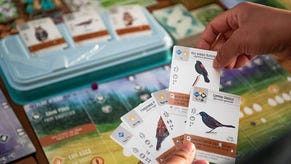How to play Wingspan: board game’s rules, setup and how to win explained
Everything you need to know to get started with the birdy board game.
Wingspan is a board game about attracting different types of birds – but how do you play Wingspan? Wingspan’s wildlife theme and beautiful artwork help it to stand out amongst other board games, though it offers more of a challenge than many other family board games like Catan, Uno and Cluedo.
How to play Wingspan
- How long does it take to play Wingspan?
- How do you start a Wingspan game?
- How to play Wingspan
- When does Wingspan end?
- How does scoring work in Wingspan?
- What is caching and flocking in Wingspan?
- Is Wingspan fun with two people?
- Is Wingspan hard to play?
Designed by Elizabeth Hargrave and published by Stonemaier Games, Wingspan is undeniably a popular game, appearing on the likes of the UK television show Coronation Street and even seeing a vinyl release of the soundtrack for its digital board game version.
Even if you’ve heard of Wingspan, you might be in need of some help with setting it up and playing for the first time, if you’re not familiar with similar board games. From setup to scoring, this guide will teach you everything you need to know about how to play Wingspan.
How long does it take to play Wingspan?
How long Wingspan takes to play depends on how many players there are and how new they are to the game. On average, a full game of Wingspan can take between 40 to 70 minutes (or just over one hour) to play – with the group needing to expect a longer playtime if they’re not familiar with Wingspan.
How do you start a Wingspan game?
In order to start playing Wingspan, you’ll need to set up the necessary components.
The Wingspan box includes a deck of bird cards – they'll have blue backs - that you will need to remove from its packaging and shuffle, before placing it onto the table. You’ll also find a card tray in the box that you can place onto the table. Fill each of its slots with a face-up card from the bird deck.
Take all the food tokens – which depict fruit, slugs, wheat, mice and fish – and the egg tokens out of the box before placing them on the table in two separate piles.
Put together the bird feeder tower and place all the food dice into the tray at the bottom.
You can choose between two different goal boards, which will decide what kinds of scoring objectives you’ll be trying to achieve each round. The green board – showing the 1st, 2nd and 3rd player scoring - provides more directly competitive objectives, while the blue board offers a less intense experience. We recommend you play the blue board for your first playthrough.
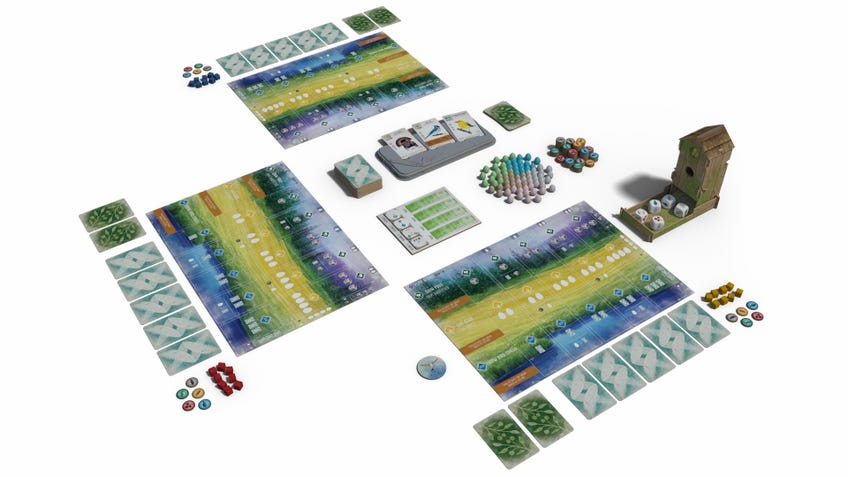
Remove the goal tiles and shuffle them without looking at them. Next, draw and place one for each of the four spaces on the goal board – they’re double-sided, so it doesn’t matter which side up you put them in.
Grab the bonus cards, which have green backs, shuffle them and place them onto the table.
Every player gets a player board, eight of the small action cubes matching their chosen player board colour, two of the bonus cards and five bird cards – which they draw randomly and should not reveal to the other players - as well as one of each of the food tokens.
Players are free to keep all of their bird cards but must discard a food token for each of the cards they choose to keep. Only a single bonus card can be held by each player, so they’ll need to choose one to discard.
The starting player is randomly chosen. They receive the first player token, which depicts the art on the front of the box. You’re ready to start playing Wingspan!
How to play Wingspan
Playing Wingspan involves taking one of four potential actions on your turn across a series of four rounds.
Every round will feature a certain number of turns per player, with the first round having eight turns for each player, the second seven per person, the third six and the fourth five. Each turn can be marked by players placing one of their matching coloured action cubes onto their chosen action, with the number of available cubes reducing with every subsequent round.
The overall goal of Wingspan is to score the most points by playing various bird cards, collecting eggs and gathering food.
Playing bird cards
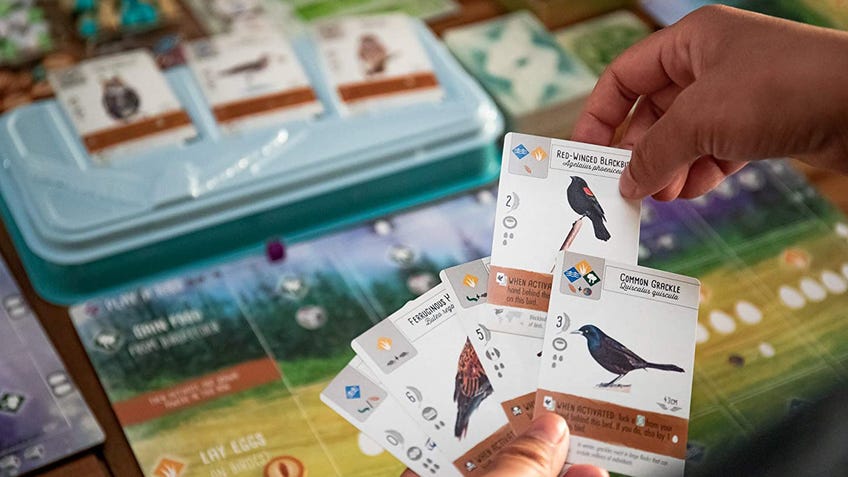
Players begin the game with their chosen food tokens and bird cards. Bird cards require players to pay a certain number of food tokens of a specific type, with their cost listed on the top left of the card. Which bird cards and food tokens you choose to keep at the beginning of the game may depend on whether you can use one to pay for the other.
Some bird cards allow you to pay any type of food token, represented by the multi-coloured wild symbol. You can also exchange two food tokens of the same type to replace one other type of food token when paying to play a bird card. You may only play one bird card at a time.
You’ll want to play bird cards because many will give you points, as well as grant unique abilities and provide spaces to place eggs. Bird cards will not only require food tokens but also need to be played onto the leftmost free space on the habitat row matching the symbol shown on the top left of the card. Some spaces further on the right on the player board habitats will require you to pay eggs to be used for a bird card.
Place one of your action cubes onto the very top section of your player board if you want to play a bird card on your turn.
Each of the three habitats have actions attached to them which, when performed, will trigger the abilities of certain bird cards placed within them – this will be indicated in the text shown on the bird cards. For instance, the Blue-Gray Gnatcatcher will allow you to take a slug from the supply whenever you perform the action attached to the habitat it’s placed in. This means that doing actions will not only get you the benefit from the action itself, but also the benefits from the bird cards placed within the attached habitat.
Meanwhile, some card abilities will trigger in response to other players performing actions or will happen whenever they’re played on the player board.
Getting bird cards
Getting bird cards is a separate action attached to the Wetlands habitat – at the bottom of the player board - with players being able to take a certain number of bird cards from either the card tray or randomly from the facedown deck. The more bird cards you already have placed in the Wetlands habitat, the more cards you’ll be able to take.
Which bird cards you choose to take can depend on the requirements for your bonus card and on the goals for each round – as well as their abilities. Every bird card will have iconography listed down its left side, this iconography relays information including how many points the card is worth, what kind of nest it has and how many eggs it can lay. The right-hand side of the card features the bird’s wingspan width.
Bonus cards will grant you additional points for having bird cards with certain aspects in your habitats on your player board. For example, having at least three bird cards with cavity nests could get you six points. This means that you might want to take bird cards that match your bonus card requirements and/or the requirements for the current round scoring goal – which work similarly to bonus cards.
When you select your bird cards you must take them into your hand to start with, as playing bird cards is a separate action that sometimes requires you to pay food tokens. There is no hand limit, meaning that players can hold as many cards as they like. Whenever bird cards are taken from the card tray, those empty tray spaces are refilled with the card at the top of the deck.
Performing this action with activate the abilities of any relevant bird cards placed in the Wetlands habitat. You will also need to place an action cube on the left-hand section of the Wetlands habitat.
Getting food tokens
Gaining food tokens is an action attached to the Woodlands/Forest habitat – the second section down on the player board - and allows players to acquire the food tokens needed to play bird cards.
When performing the gain food action, players may take a number of food tokens depending on how many food dice they’re able to use. The more bird cards you have placed in your Woodlands/Forest habitat, the more dice you’ll be able to use. Players can also spend bird cards in exchange for more food dice.
The food dice will be sat within the tray containing the bird feeder dice tower, with any used dice being placed outside the tray. Whenever players perform the gain food token action and there aren’t any dice in the tray, all five dice outside the tray are rolled via the bird feeder dice tower and are available to use once again. This means you might want to time your gain food token action around a re-roll, if nothing currently sat in the tray is useful to you.
Players take the matching food token from their chosen dice. Any sides showing multiple food tokens separated by a line indicates that the player may choose between those options. For instance, a slug or a wheat token.
There is not a limit on the number of food tokens players can have. Whenever the group runs out of a certain type of food token, they can use another to act as a stand in.
Whenever players perform the gain food action, any bird cards placed in the Woodland/Forest habitat will have their abilities activated – if they have any. When performing this action, you should place an action cube onto the left-hand side of the Woodland/Forest habitat.
Laying eggs
Choosing the lay eggs action enables players to place egg tokens on the bird cards on their player boards.
The number of eggs you can place depends on how many bird cards you currently have placed in your Grassland habitat – which is attached to the lay eggs action and is the third section down on the player board. The more bird cards you have in your Grasslands habitat, the more eggs you can place on your turn. Some spaces on your Grasslands habitat section of your player board will enable you to pay food tokens to lay additional eggs.
Placing eggs requires that you have bird cards with available egg slots on your player board. Each bird card will be able to have a set number of eggs placed on it, meaning you’ll need to keep track of which bird cards have how many slots left open before performing the lay eggs action.
Laying eggs will enable you to meet certain round scoring goals and bonus card scoring goals, as well as count for points by themselves. For instance, a round scoring goal could be to have the most eggs in bowl nests. Some bird cards will show a star symbol where the nest symbol would usually be, which means that their nests are wild and can score for any type of nest scoring goal – making them extra useful.
When performing this action, any bird cards placed in the Grasslands habitat with relevant abilities will activate. Players need to put an action cube onto the left-hand side of the Grasslands habitat when performing this action.
Ending a round

The end of the round arrives when all players have used every one of their action cubes and performed their turns.
Remove all the action cubes from every player’s board, players then use these cubes to mark their end-of-round scoring.
How end-of-round scoring works will depend on which side of the goal board you’re using.
The green side will have the players place cubes on either the first, second, third or fourth spaces - or off the board if they’re taken fifth place – depending on how successful they were in achieving the scoring goal for that round. Only the first, second and third spaces will score points on this side of the board.
The blue side will see players placing their cubes on one of the six available spaces, with each space representing how many of their bird cards – including those holding eggs – have fulfilled the round scoring goal, with a maximum of five.
All the bird cards shown in the card tray are then discarded into a separate pile, before each space in the card tray is refilled with another card.
The first player token is then given to the player to the left of the current first player and the next round begins.
When does Wingspan end?
A game of Wingspan ends when all players have completed their turns on the last round, which will depend on how many people are playing.
The winner is whoever has the most points by the end of the game.
How does scoring work in Wingspan?
Players score points in Wingspan in several different ways:
- Playing bird cards worth points
- Playing bird cards that fulfill round scoring goals
- Playing bird cards that fulfill bonus scoring goals
- Laying eggs on bird cards
- Laying eggs on bird cards that fulfill round scoring goals and bonus scoring goals
- Placing – caching – food tokens on bird cards
- Any cards placed underneath any other bird cards
All points are totaled and assigned at the very end of the game.
What is caching and flocking in Wingspan?
Some bird cards in Wingspan will allow players to cache and flock.
Caching is when a food token – either from your supply or from the shared player pool – is placed onto either the bird card granting the ability or another bird card. Doing this will grant you additional points at the end of the game.
Flocking is when you’re able to place another bird card - either from your hand or from the deck – underneath a bird card. Doing this will get you more points at the end of the game.
Is Wingspan fun with two people?
Wingspan is a board game for one to five players. The main difference between the player counts will be the number of turns per each round – with eight turns per player on round one and the number descending with each round thereafter. Each player gets their own player board in Wingspan, meaning that having fewer or more players just means using fewer or more player boards.
Wingspan is a fun board game regardless of how many players there are – as long you have enough player boards – you can even play it as a solo game thanks to the Automa rules that come with every copy of the game.
Is Wingspan hard to play?
Whether Wingspan is hard to play will depend on how much experience you and your fellow players have with board games. While Wingspan is far from the most complicated board game, it’s still a good idea to make use of the swift-start guides included in the box. The swift-start guides provide new players with a more forgiving start to Wingspan and a tutorial on how to play. The first player needs to have the Player 1 guide.
With the swift-start guide players begin the game with a specific set of cards marked by grey corners, which they’ll take alongside certain food tokens indicated by the swift-start guides. Following the instructions listed on the swift-start guides will lead each player through their first few actions, besides the fifth player – as hopefully, by watching their fellow players, they should have an idea of what to do. Once the swift-start guides have been used, shuffle the grey-cornered cards into the main bird deck.
